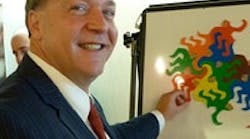Many high-school students rule out careers in science and technology because they find classes on the subjects dull, daunting or disconnected from their world. I've sporadically written about the need to break down such barriers. Last month, for instance, I lauded an initiative that caters to many teenagers' love of online gaming ("Could You Be The Ultimate Plant Manager?")
Often, probably ignorance or fear of mathematics underlies or amplifies aversions to science and technology. So, we must convince students that math is fascinating, not frightening. That's the aim of an ambitious venture called MoMath. "Our dynamic exhibits and programs will stimulate inquiry, spark curiosity and reveal the wonders of math," trumpets its website (http://momath.org).
MoMath is short for the Museum of Mathematics, which is set to open during the fall of 2012 at 11 East 26th Street in New York City. The nonprofit institution will occupy the ground floor and lower level of the 20-story building, and will contain 50 to 60 interactive hands-on exhibits, as well as classrooms, an auditorium and a gift shop, spread over 19,000 ft2 of space.
The idea for the museum arose after the small Goudreau Museum of Mathematics in Art and Science in New Hyde Park, N.Y., closed. In August 2008, a group led by Glen Whitney, a former university math teacher and hedge-fund quantitative analyst, who now is executive director of MoMath, decided to look into creating a more ambitious museum. The group quickly discovered that America didn't have a museum of mathematics. Such museums exist elsewhere, including in Germany, Italy, Japan and South Korea.
MoMath intends to bring something new to the field, says Whitney. "We aim to be tops in interactivity and tops in covering the broadest range of mathematical topics. We want to expose the entire world of mathematics."
The museum will contain a number of thematic sections (such as one on infinity), each with several exhibits -- many of which will involve collaborative activities -- as well as a mathematical art gallery. Displays will change on a regular basis to keep the experience fresh, adds Whitney.
A $30-million capital campaign has raised $22 million so far. In early April, MoMath received a $2-million grant from Google, which will go toward developing the state-of-the-art museum as well as creating hands-on math exhibits that will travel to museums worldwide.
MoMath's advisory council includes more than a score of academics as well as people from a mathematical software maker, authors of books on mathematics and mathematical puzzles, and individuals involved in initiatives to engage students in math. Whitney would welcome adding some engineers from industry to the council.
Already MoMath runs "Math Midway," a hands-on exhibit that travels throughout the country. Here, children (and adults) can ride a square-wheeled tricycle, and can place a translucent solid in a light to get a glowing two-dimensional shape that changes as the solid is moved, among other activities.
Math Midway will be at the World Science Festival Street Fair in New York City (June 5), and then head to the Discovery Center for Science and Technology in Thousand Oaks, Calif. (June 17 to August 12), the Liberty Science Center in Jersey City, N.J. (Oct. 7 to Jan. 22, 2012), the Boonshoft Museum of Discovery in Dayton, Ohio (Feb. 4 to April 29), the Maryland Science Center in Baltimore, Md. (May 26 to Sept. 3), and the Museum of Discovery and Science in Fort Lauderdale, Fla. (Jan. 26, 2013, to May 5).
In addition, MoMath recently launched a series of presentations called "Math Encounters" that are aimed at children from 12 years old and up as well as adults. The first two events drew nearly 600 people. Upcoming sessions include "Soap Bubbles and Mathematics: The Amazing Shapes of Minimal Surfaces" (June 8), "From Points to Paints: How Math Altered the Course of Modern Art" (July 6), "Fibonacci Numbers and the Golden Ratio: Most of What You Have Read is False, but the True Stuff is Fascinating" (Sept. 7), and "Good News Everyone! Mathematical Morsels from The Simpsons and Futurama" (Oct. 5). All take place at a site in Manhattan. MoMath plans to make videos of many of the sessions available on demand from its website.
The museum's goal is to attract 60,000 visitors during 2013. Let's hope MoMath succeeds exponentially.
MARK ROSENZWEIG, Chemical Processing's Editor in Chief, has no fear of mathematics. You can e-mail him at [email protected]
